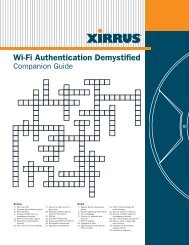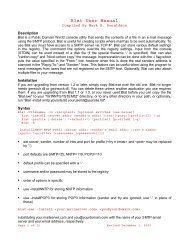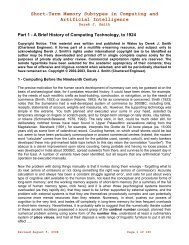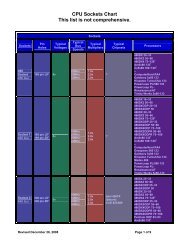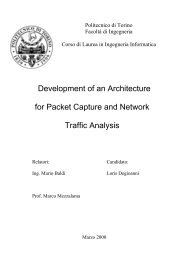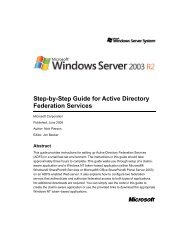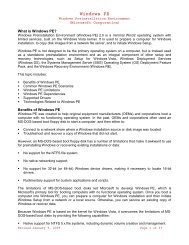SCO UnixWare 2.1 Technical Summary - Bandwidthco Computer ...
SCO UnixWare 2.1 Technical Summary - Bandwidthco Computer ...
SCO UnixWare 2.1 Technical Summary - Bandwidthco Computer ...
You also want an ePaper? Increase the reach of your titles
YUMPU automatically turns print PDFs into web optimized ePapers that Google loves.
An <strong>SCO</strong> <strong>Technical</strong> White Paper Version <strong>2.1</strong>.2<br />
Two basic port monitors are provided with the system:<br />
ttymon serial port monitor<br />
listen network monitor that provides connection services<br />
regardless of a network’s communications protocol.<br />
The ttymon port monitor performs the functions that getty and uugetty performed in earlier<br />
releases of the UNIX system. It has the following functions:<br />
• initializes and monitors terminal ports<br />
• sets terminal modes and line speeds for each port it monitors<br />
• identifies and authenticates users<br />
• invokes the service associated with a given port whenever it receives a connection<br />
request on that port.<br />
The use of ttymon provides much more flexibility than the use of getty/uugetty. It can provide a<br />
configurable set of services in addition to login service. The listen port monitor monitors a<br />
connection-oriented transport network, receiving incoming requests, accepting them, and<br />
invoking the services that have been requested. It differs from other listeners (such as inetd) in<br />
several important ways:<br />
• it allows private addresses for services.<br />
• passes connections to standing servers.<br />
• supports socket-based services.<br />
• supports RPC-based services and dynamic addressing.<br />
Authentication Services<br />
Identification and authentication services are supported in <strong>SCO</strong> <strong>UnixWare</strong> <strong>2.1</strong> to maintain<br />
network application security. A basic connection server process is run to support the<br />
establishment of connections for all network services that communicate over network and dialup<br />
connections. The connection server :<br />
• receives requests for network services from client machine applications,<br />
• establishes connections to the server-machine ports associated with the requested<br />
services<br />
• passes the connections back to the application.<br />
Before passing a connection to an application, the connection server may invoke an<br />
authentication scheme. The cr1 identification and authentication scheme is used on <strong>SCO</strong><br />
<strong>UnixWare</strong> <strong>2.1</strong> to protect systems from unauthorized access. cr1 uses DES encryption by<br />
default, but it can use ENIGMA encryption and other encryption schemes as well to satisfy export<br />
restrictions.<br />
Internet Security Services<br />
The integrated web server and authoring tools make it easy to establish an Internet presence or<br />
publish key information via an intranet. However it is as important to easily secure your company<br />
data and control and protect access to these servers from outside. The Navigator browser<br />
provides for server and client authentication through digital certificates. It features encrypted<br />
Usenet news and conferencing capabilities It uses SSL based connection routing and open<br />
security features using the Secure Sockets Layer 3.0 (SSL) open protocol . Access to<br />
documents, directories and applications may be granted to a particular user, group, IP address,<br />
hostname or domain name.<br />
22



